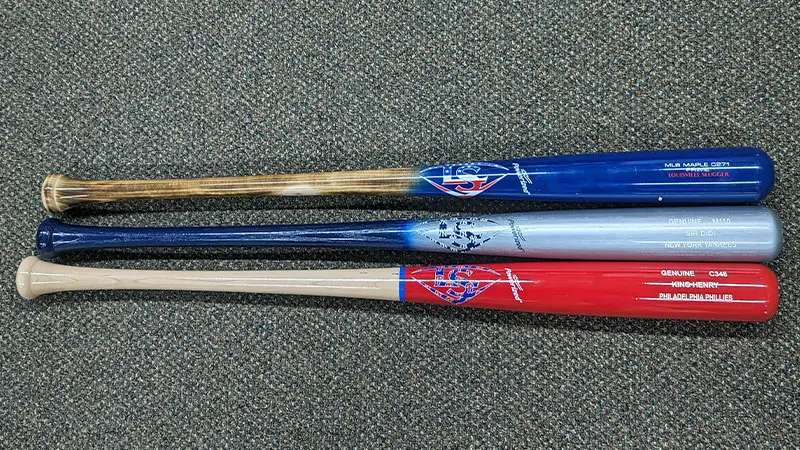Curious about why MLB players swing wooden bats? You’re not alone. The debate between wood and metal bats has sparked countless discussions, but in Major League Baseball, the choice is clear.
MLB regulations mandate the use of wooden bats, and these aren’t just any wooden bats they must meet specific criteria, including hardness, diameter, and grain straightness.
Why such strict rules? The reasons boil down to performance and tradition. Wooden bats have been a staple in the MLB for over a century, offering a unique blend of durability and skill that metal bats can’t replicate.
So, whether you’re a die-hard baseball fan or just curious about the sport, understanding the significance of wooden bats in the MLB adds a layer of appreciation for the game.
Historical Context of Wooden Bats in MLB
Wooden bats have a rich historical context in Major League Baseball (MLB), shaped by tradition, performance considerations, and safety concerns.
Here are some key points:
The Tradition of Using Wooden Bats
Wooden bats have been a staple in baseball since the sport’s inception. Early players crafted their own bats from various wood types, making the use of wooden bats a symbol of the game’s rich history.
The tradition of using wooden bats has persisted through generations, connecting today’s players with those from the past.
Besides tradition, the use of wooden bats in Major League Baseball (MLB) also prioritizes player safety. Wooden bats tend to break instead of splintering dangerously, reducing the risk of injury.
Additionally, wooden bats highlight a player’s true skill, as they require more precision and power to hit effectively.
In contrast, aluminum or composite bats can give an unfair advantage due to their enhanced power and durability, fundamentally altering the dynamics of the game.
Evolution of Bat Materials in Baseball
Through the mid-1800s, players exclusively used wooden bats. Experimenting with different materials began later. For instance, in light of performance concerns, some players attempted to modify their bats by filling them with cork or rubber superballs.
However, these modifications weakened the bats, demonstrating the resilience of wood as the preferred material. Modern regulations mandate that MLB bats adhere to specific standards for hardness, diameter, and grain straightness to ensure quality and consistency.
Wood remains the primary material for bats due to its historical significance and its contribution to the integrity and fairness of the game.
Changes in bat designs, like adding cork or switching to metal, have been considered but ultimately rejected to preserve the sport’s essence.
Performance and Safety Concerns
The use of wooden bats in Major League Baseball (MLB) is not just a matter of tradition; it also involves significant considerations regarding performance and safety.
Here’s a deeper look into these aspects:
How Wood Affects Ball Dynamics
Wooden bats profoundly influence ball dynamics in baseball, impacting crucial aspects such as ball exit velocity, trajectory, and defensive play.
Ball Exit Velocity
Wooden bats lack the trampoline effect seen in non-wooden bats like aluminum or composite materials. This means they do not compress upon impact, resulting in generally lower ball exit velocities.
However, factors such as the type of wood (e.g., ash, maple) and bat construction can influence how efficiently energy is transferred to the ball, potentially affecting exit velocity.
Ball Trajectory
Achieving desired ball flight paths with wooden bats requires precise hitting mechanics. Without the trampoline effect to rely on, players must generate power through their own strength and technique.
Each wooden bat has a distinct sweet spot, and hitting the ball here optimally transfers energy and controls trajectory.
Defensive Play
Fielders react differently to balls hit with wooden bats compared to non-wooden ones. The lower exit velocities from wooden bats can give fielders more reaction time, influencing defensive strategies and positioning.
Additionally, the risk of bat breakage upon contact can alter the trajectory of the ball unexpectedly, affecting defensive play and potentially posing safety risks to fielders.
Regulatory Impact
Major League Baseball regulates bat dimensions and materials to maintain fair play and safety. Wooden bats must comply with strict standards to ensure consistent performance and mitigate safety risks associated with breakage and ball impact.
Safety Risks with Non-Wood Bats
Non-wood bats, like aluminum and composite variants, present significant safety risks due to their construction. These bats can have larger sweet spots and manipulated swing weights.
Balls hit off non-wood bats can exceed 130 mph, endangering pitchers and infielders. The increased ball speed and uneven energy transfer can harm both players and spectators.
The BBCOR standard aims to limit these dangers by matching non-wood bats’ performance to wood, but inconsistencies remain.
Moreover, breaking wooden bats poses less risk compared to metal fragments flying into the stands, which keeps the game safe for everyone involved.
Impact on the Game
Wooden bats have a profound impact on the game of baseball, influencing various facets that contribute to the sport’s essence and strategic nuances.
Influence on Batting Averages
Wooden bats affect batting averages by ensuring consistent performance across games. Since wooden bats provide less “trampoline effect” compared to aluminum or composite bats, the ball travels at a moderate speed when hit.
This balance maintains average batting performance, making it more reflective of the player’s skill rather than the equipment used.
For example, the trampoline effect in metal bats can make the ball travel faster and farther. This would result in inflated batting averages if permitted in MLB, distorting the players’ true capabilities.
Therefore, using wooden bats helps in providing a more accurate representation of a player’s hitting ability.
Record Integrity and Comparisons Across Eras
Wooden bats preserve the integrity of baseball records. When comparing players from different eras, consistency in equipment is crucial.
Wooden bats ensure that records remain comparable as they have been used throughout the history of MLB.
For example, the shift from wooden to metal bats would dramatically change hitting statistics, creating discrepancies in how records are viewed.
Players in the past achieved their records using wooden bats, meaning current players using the same type of bats help maintain a level playing field.
Using wooden bats helps maintain a continuity in the game, ensuring that achievements are measured on a similar scale across different periods.
This makes it easier to compare modern players with legends from previous generations, preserving the sport’s rich history and heritage.
Material Science Behind MLB Bats
The construction of bats used in Major League Baseball (MLB) involves intricate material science considerations that impact performance, durability, and regulatory compliance.
Types of Woods Used
MLB players exclusively use wooden bats, with common types being maple, ash, and birch.
Each wood type offers unique characteristics that influence performance:
Maple
Dense and hard, providing increased durability and power. Additionally, wooden bats offer more traditional aesthetics and comply with MLB’s regulations that aim to maintain the integrity of the game.
This choice also ensures player safety by reducing the risk of extreme ball exit speeds compared to aluminum bats.
Ash
Flexible, offering a larger sweet spot and smoother swing. However, for professional leagues like the MLB, the primary reason they exclusively use wooden bats is to maintain the traditional integrity of the game.
Birch
Combines hardness and flexibility, balancing power and control. Additionally, wooden bats provide a traditional element to the game that honors its history, while ensuring player safety by reducing the risk of high-speed injuries from faster batted balls.
Why Wood Prevails Over Metal and Composite Options
Wooden bats are preferred in MLB for several reasons:
Tradition
Wood bats have been used historically, maintaining the sport’s heritage. In addition, the use of wooden bats ensures a more balanced and safer game, preventing balls from being hit at excessively high speeds as compared to aluminum bats.
Safety
When wooden bats break, they typically splinter, posing less risk than metal bats, which can dent or crack dangerously.
Additionally, wooden bats provide a more balanced competitive environment, as they do not offer the same power advantages as metal bats. This ensures player safety and preserves the game’s integrity.
Game Integrity
Wood’s consistent performance ensures fair play, as all players use bats with similar qualities. Additionally, wooden bats enhance player safety by reducing the speed of batted balls, thus minimizing injury risks. This tradition upholds the game’s historical integrity and challenges athletes.
Skill Emphasis
Hitting with wood requires precise technique, emphasizing player skill and contributing to balanced gameplay.
Moreover, wooden bats reduce the risk of injury by breaking rather than bending, ensuring safety for players. This tradition also preserves the historic essence of baseball, maintaining its timeless appeal.
Frequently Asked Questions
Why doesn’t MLB allow metal bats?
Aluminum bats offer unparalleled speed and power, allowing players to generate greater velocity, which can be dangerous for players and spectators at the Major League Baseball (MLB) level.
Do metal bats hit farther than wood bats?
Yes, metal bats generally hit the ball farther because they are lighter and easier to swing, providing a significant performance advantage in terms of distance.
Why do MLB players use wooden bats instead of metal?
Wooden bats are required in pro leagues to protect historical records and ensure that game performance reflects human skill rather than technological enhancements.
Do MLB bats have to be wood?
Yes, MLB regulations, specifically Rule 1.10(a), dictate that bats must be made of solid wood, ensuring consistency and fair play across the league.
Do MLB players tape their bats?
Yes, many MLB players use grip tapes to improve performance and feel. A new batting grip tape can boost a player’s confidence, especially when they’re struggling at the plate.
Conclusion
Wooden bats in MLB aren’t just a nod to tradition; they play a crucial role in maintaining the sport’s integrity and safety.
Their unique characteristics, derived from different types of wood, influence player performance in ways that metal or composite bats can’t replicate.
MLB regulations ensure that these standards are upheld, promoting fair play and balanced competition. By sticking with wooden bats, MLB preserves the essence of the game while emphasizing skill and safety for all players.
Moreover, wooden bats tend to break more easily than metal ones, which controls the power and speed of hits, ultimately making the game safer. This choice reflects MLB’s commitment to keeping baseball a strategic and skill-based sport.








Pat Bloom